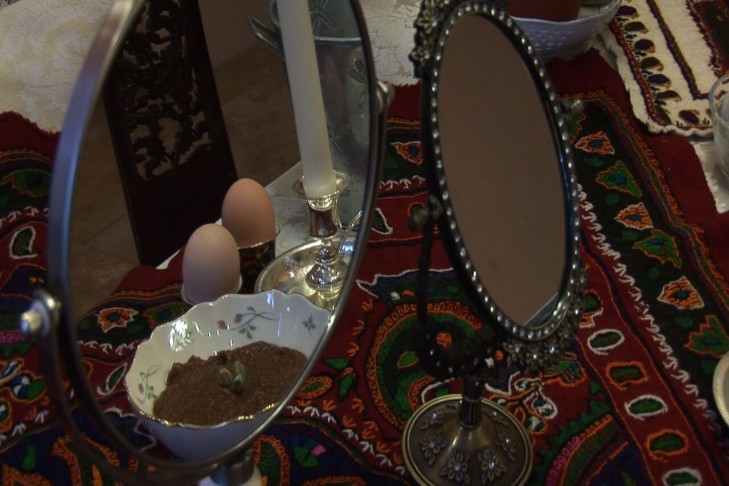“The pearl that slipped its shell” is a line from the Persian poet Hafez, and the title of Wendy Wolfe Fine’s art installation at the Hadassah-Brandeis Institute (HBI). Fine is the current artist-in-residence at HBI, and she pays brief homage to Hafez through the Mizrahis, a Jewish-Iranian family who is the subject of and inspiration for Fine’s installation.
Hafez is considered a national hero in Iran, and his verse can be found in most Iranian homes. That was true for the Mizrahi family, who considered the poet an integral part of their cultural history. The family patriarch, Souleiman Mizrahi, carried a book of Hafez’s poetry when he traveled and wrote down his favorite lines in an exquisite calligraphy that hung in the family home in Kerman, Iran. The show’s subtext also reveals Fine’s deep love of cooking. That love initially led to an abiding friendship with Sharona Mizrahi, a Newton resident and one of the 10 children in the Mizrahi family.

“A lot of my work,” said Fine in a recent interview, “has a food component to it.” Fine’s work encompasses a variety of genres, including film, photography and collage. She also notes that she has been evolving as a filmmaker over the last decade. To that end, she first combined her work as “a time-based artist” with her interest in food in a film called “Salad Stories.” The premise was clear-cut for Fine: Film Israelis from all walks of life making salad. Fine, who spends her summers in Israel, said that her goal was not only to include “the specifics of the salad, but to also capture a broader history of the families making them.” Fine is still collecting more stories to include in the film.
Fine comes to HBI with a freshly minted master of fine arts degree from Lesley University in Cambridge. Leading up to her degree, she honed her technical skills in filmmaking at the Center for Digital Imaging Arts in Waltham. While earning her year-long intensive certificate in filmmaking, Fine brought her crew to Sharona’s house to document her friend making traditional rice dishes and a Persian herb omelet called kuku sabzi (recipe below).
But Sharona’s stories of life in Kerman and her escape from the Islamic Revolution of 1979 also intrigued Fine. “The Mizrahis’ history is a microcosm of what happened to the Jews of Iran,” asserted Fine. “In the 1970s, the Shah promoted western education and many Iranians took the opportunity to study in the United States. The idea was that they would bring back their western ideas to Iran.” Some of the Mizrahi siblings went to the United States with the intention of returning home. But after 1979 it was clear the remaining family in Iran had to join their relatives already in America instead.
What followed was a harrowing escape in 1984 for Sharona and her family. In the interim, their father, Souleiman, had been jailed and tortured a couple of times. By the time the family was ready to leave Iran, the only options were illegal. “They closed the door to their house, left all their belongings and didn’t look back,” said Fine. The family was smuggled out of Iran through Afghanistan and Pakistan, where they applied for refugee status. They eventually made their way to Vienna and were waylaid for almost a year before immigrating to the United States.
Fine’s installation and wall text artistically fold the Mizrahi family story into her interpretative restoration of their home in Kerman. Although the family lived in the Jewish quarter, they were not confined to a ghetto. Muslims and Jews lived side by side and Jews were free to circulate throughout the city. The exhibit originates with a floor plan that Sharona drew of her home. “From Sharona’s floor plan, I proposed to recreate some of the rooms,” Fine said. “The first room is the dining room/living room, where the family always sat around a carpet to eat. There was no table or couches. I call that room ‘The Room of Loss.’ It represents what they left behind.”
To reinforce the pain and grief of the family’s loss, Fine extracted color from the room, sharply contrasting it to another space called “The Courtyard of Rejuvenation.” In the wall text, Sharona recalls the garden in the center of her courtyard in Kerman where her mother planted vegetables and herbs. Fine installed a miniature garden to symbolize the beginning of the family’s new life in the United States.
Fine also presents a model of the family’s kitchen and has included blown-up maps of the family’s escape route from Iran and their journey to freedom in the west. Another intriguing item is Fine’s “History Curtain.” In conversation, Fine noted that the curtain was purposely made up of 27 strands representing 2,700 years of Iranian history. “The beads are made of copper, walnut, turquoise and other gemstones particular to Iran. I’m a beader too, but a number of people helped with the beading of the History Curtain.”
Fine’s multimedia installation is on view at the Kniznick Gallery at Brandeis University through June 24. And on Sunday, April 17, at 1 p.m., Fine will be conducting a workshop with Sharona Mizrahi on how to make kuku sabzi.
Kuku Sabzi: Persian Herb Omelet
Ingredients
- 2 cups tarragon, finely chopped
- 2 cups cilantro, finely chopped
- 2 bunches scallions, chopped
- 2 cups spinach, finely chopped
- 8 eggs
- Salt and pepper, to taste
- Olive oil
- Turmeric
Directions
- Mix herbs and spinach with eggs. Add salt and pepper.
- Heat oil in pan and sprinkle with turmeric.
- Add egg mixture and cook, covered, for 10 minutes.
- Flip the omelet and add more turmeric. Cook for another 5-10 minutes, until done.
- Serve with thin Middle-Eastern bread, like lavash.
This post has been contributed by a third party. The opinions, facts and any media content are presented solely by the author, and JewishBoston assumes no responsibility for them. Want to add your voice to the conversation? Publish your own post here. MORE




